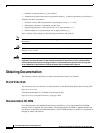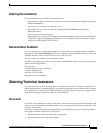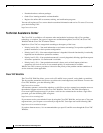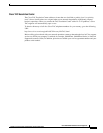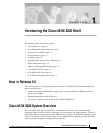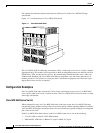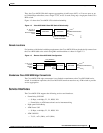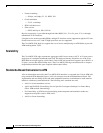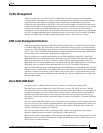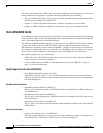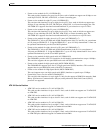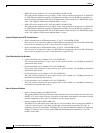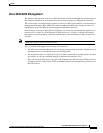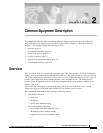
1-4
Cisco MGX 8220 Installation and Configuration
Release 5.0, Part Number 78-6430-03 Rev. D0, November 2003
Chapter
Cisco MGX 8220 System Overview
• Frame forwarding
–
56 kbps, nx64 kbps, T1, E1, HSSI, X.21
• Circuit emulation
–
T1, E1, nx64 kbps
• ISDN switched access
• SNA services
–
SDLC and bisync, DS-0, DS-0A
Physical connectivity is provided through individual HSSI, X.21, T1 or E1 ports, V.35, or through
channelized T1/E1 interfaces.
Using the service resource module (SRM), multiple T1 interfaces can be supported on physical T3 lines.
Frame based services on T3 and E3 high speed lines are also supported.
The Cisco MGX 8220 shelf also supports the use of inverse multiplexing for ATM (IMA) to provide
ATM trunking below T3/E3.
Scalability
The Cisco MGX 8220 edge concentrator aggregates traffic from as many as 80 T1 or E1 ports onto a
single port of a multiport broadband trunk card. This high port density maximizes use of the Cisco
BPX 8600 series high-capacity switch fabric. Each 9-inch rack-mount shelf supports up to 80 DS-1 or
E1 ports, or more than 2000 64-kbps users. The Cisco MGX 8220 edge concentrator has a compact
footprint that minimizes the space required within central offices.
Standards-Based Conversion to ATM
All user information received by the Cisco MGX 8220 interfaces is converted into 53-byte ATM cells
using standard ATM adaptation layers (AALs) for transport over the ATM backbone network. Cell
segmentation and reassembly (SAR) and other adaptation functions are distributed to each interface
module to eliminate system bottlenecks. The following AAL standards are used:
• AAL1 for circuit emulation services.
• AAL5 and FR-SSCS (Frame Relay Service Specific Convergence Sublayer) for Frame Relay
(FR to ATM network interworking).
• For Frame Relay to ATM service interworking, both transparent and translation modes are
supported to map FR to native ATM AAL5.
• AAL5 for Frame forwarding.



